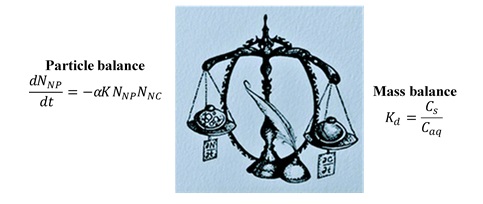Everyone loves and hates nanoparticle aggregation. Why? Because it is a fascinating phenomenon but it complicates all of our experiments, ranging from in vitro / in vivo studies, all the way to the environmental models. For ease of study, it can be broken down into homoaggregation and heteroaggregation. Investigating the former is relatively easier than the latter (relatively!), but in the real world we are forced to deal with the latter. Simply, heteroaggregation in the environment refers to attachment of ENPs to naturally occurring solids (e.g. soil particles, suspended sediments). This plays a key role in determining ENPs bioavailability and mobility in the environment.
Large-scale fate and transport models have been adapted for modelling of ENPs. Earlier models use mass balance as a framework with partition coefficients (Kd) to describe the soil-water distribution of ENPs, but recent studies argue that particle number-based kinetic models using attachment efficiency (α) are better at this, given that colloidal suspensions never reach an equilibrium state as well as ignore the size dependent properties. Yet no agreement has been established on the best way to treat heteroaggregation in these models.
Therefore, to shed light on this matter, Amy L. Dale (Engineering and Public Policy, Carnegie Mellon University, PA), Gregory V. Lowry (Civil and Environmental Engineering, Carnegie Mellon University, PA), and Elizabeth A. Casman (CEINT, Duke University, NC) discuss in detail the ongoing practical challenges in model formulation, parameterization, and calibration for ENPs in their perspective.
A couple of highlights in this article are:
– Particle balance models are more complex, making it challenging to parameterize ENPs in the environment. Therefore, many assumptions are needed that have been discussed in detail in the perspective.
– Attachment efficiency is agreed to be the most appropriate fate descriptor for small-scale models, but at large-scale these models it is claimed to be relative insensitive to the particulate nature of ENPs.
Given the lack of scientific understanding on ENP heteroaggregation it was suggested that balance models to be the better choice, at least in the short term. Overall rates of sorption and desorption has been suggested to be used in the place of equilibrium partition coefficients to overcome concerns arising from using the equilibrium Kd.
To access the full article, download a copy for free* by clicking the link below.
Much ado about α: reframing the debate over appropriate fate descriptors in nanoparticle environmental risk modeling
Amy L. Dale, Gregory V. Lowry, Elizabeth A. Casman
Environ. Sci.: Nano, 2015, Perspective
DOI: 10.1039/C4EN00170B
—————-
About the webwriter
Imali Mudunkotuwa is a Postdoctoral Scholar and Research Assistant at The University of Iowa. She is interested in nanoscience, physical and surface chemistry. You can find more articles by Imali in her author archive .
—————-
* Access is free through a registered RSC account











